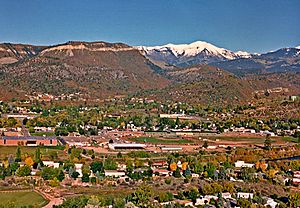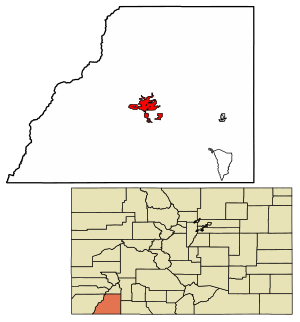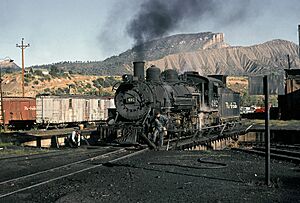Durango, Colorado facts for kids
Quick facts for kids
Durango, Colorado
|
||
|---|---|---|

Durango as seen from Rim Drive
|
||
|
||
| Motto(s):
"Open Spaces and Familiar Faces"
|
||

Location of the City of Durango in La Plata County, Colorado
|
||
| Country | ||
| State | ||
| County | La Plata County seat | |
| Founded | 1880 | |
| Incorporated | April 27, 1881 | |
| Government | ||
| • Type | Home rule municipality | |
| Area | ||
| • Home Rule City | 17.103 sq mi (44.296 km2) | |
| • Land | 14.708 sq mi (38.093 km2) | |
| • Water | 2.395 sq mi (6.203 km2) | |
| Elevation | 6,532 ft (1,991 m) | |
| Population
(2020)
|
||
| • Home Rule City | 19,071 | |
| • Density | 1,297/sq mi (501/km2) | |
| • Metro | 55,638 | |
| Demonym(s) | Durangoan | |
| Time zone | UTC−07:00 (MST) | |
| • Summer (DST) | UTC−06:00 (MDT) | |
| ZIP codes |
81301-81303
|
|
| Area code(s) | 970 | |
| FIPS code | 08-22035 | |
| GNIS ID | 202983 | |
Durango is a city in Colorado, United States. It is the main city and county seat of La Plata County. In 2020, about 19,071 people lived there. Durango is also home to Fort Lewis College.
Contents
History of Durango
Durango was started between 1880 and 1881 by the Denver and Rio Grande Railroad. The railroad wanted to reach Silverton, Colorado, to help the mining industry there. They chose a spot near the Animas River for their railroad buildings.
The city was named by ex-Colorado Governor Alexander C. Hunt. He named it after Durango, Mexico, because he liked that city. A company called the Durango Trust helped plan the city. They sold land and laid out streets like Main Street.
When the railroad line to Silverton was finished, Durango grew very fast. By 1885, the city had many businesses. There were seven hotels, eleven saloons, and various shops. The railroad was very important for moving goods and minerals. It helped Durango's economy a lot.
However, the Great Depression and World War II made things hard for the railroad. Some train services stopped. But people soon realized the beautiful scenery along the Silverton line was a big draw. This led to a new industry: tourism!
The railroad started taking visitors to Silverton and back. This also brought Hollywood to the area for a while. In 1981, the Silverton line was sold. It became the famous Durango and Silverton Narrow Gauge Railroad.
There are many old and important archaeological sites near Durango. These sites show how people lived long ago. Some of them are:
- Mesa Verde National Park, a World Heritage site
- Chimney Rock National Monument, an ancient outpost
- Durango Rock Shelters Archeology Site, a Basketmaker and Pueblo site
- Spring Creek Archeological District, another Basketmaker and Pueblo site
- Talus Village, a Basketmaker site
Durango's Geography
In 2020, Durango covered an area of about 44.3 square kilometers (17.1 square miles). About 6.2 square kilometers (2.4 square miles) of this area is water.
Durango's Climate
Durango has a climate that is like a humid continental climate but with some Mediterranean influences.
| Climate data for Durango, Colorado, 1991–2020 normals, extremes 1991–2018 | |||||||||||||
|---|---|---|---|---|---|---|---|---|---|---|---|---|---|
| Month | Jan | Feb | Mar | Apr | May | Jun | Jul | Aug | Sep | Oct | Nov | Dec | Year |
| Record high °F (°C) | 60 (16) |
71 (22) |
78 (26) |
84 (29) |
98 (37) |
96 (36) |
99 (37) |
95 (35) |
96 (36) |
86 (30) |
72 (22) |
62 (17) |
99 (37) |
| Mean maximum °F (°C) | — | — | — | — | — | 81.3 (27.4) |
85 (29) |
82.3 (27.9) |
75.7 (24.3) |
64.3 (17.9) |
50.1 (10.1) |
39.9 (4.4) |
85 (29) |
| Mean daily maximum °F (°C) | 39.2 (4.0) |
45 (7) |
54.1 (12.3) |
62.8 (17.1) |
71.3 (21.8) |
81.3 (27.4) |
85 (29) |
82.3 (27.9) |
75.7 (24.3) |
64.3 (17.9) |
50.1 (10.1) |
39.9 (4.4) |
62.6 (16.9) |
| Daily mean °F (°C) | 26.1 (−3.3) |
31.8 (−0.1) |
39.6 (4.2) |
46.4 (8.0) |
54.3 (12.4) |
63.5 (17.5) |
68.9 (20.5) |
66.9 (19.4) |
60.1 (15.6) |
48.6 (9.2) |
36.4 (2.4) |
26.7 (−2.9) |
47.4 (8.6) |
| Mean daily minimum °F (°C) | 13 (−11) |
18.6 (−7.4) |
25.1 (−3.8) |
30 (−1) |
37.2 (2.9) |
45.6 (7.6) |
52.9 (11.6) |
51.5 (10.8) |
44.5 (6.9) |
32.9 (0.5) |
22.7 (−5.2) |
13.4 (−10.3) |
32.3 (0.1) |
| Record low °F (°C) | −12 (−24) |
−5 (−21) |
0 (−18) |
10 (−12) |
21 (−6) |
28 (−2) |
35 (2) |
40 (4) |
26 (−3) |
11 (−12) |
−2 (−19) |
−14 (−26) |
−14 (−26) |
| Average precipitation inches (mm) | 2.17 (55) |
1.71 (43) |
1.32 (34) |
1.25 (32) |
1.18 (30) |
0.53 (13) |
1.92 (49) |
2.28 (58) |
2.22 (56) |
1.93 (49) |
1.46 (37) |
1.65 (42) |
19.62 (498) |
| Average snowfall inches (cm) | 19.4 (49) |
15.4 (39) |
5.3 (13) |
3.8 (9.7) |
0.2 (0.51) |
0 (0) |
0 (0) |
0 (0) |
0 (0) |
1.1 (2.8) |
5.5 (14) |
13 (33) |
63.7 (161.01) |
| Average precipitation days (≥ 0.01 in) | 7.1 | 8 | 6.6 | 6.6 | 6.7 | 4.4 | 11.3 | 12.6 | 8.7 | 7.3 | 6.5 | 7.1 | 92.9 |
| Average snowy days (≥ 0.1 in) | 6.9 | 6.5 | 3.8 | 2.2 | 0.2 | 0 | 0 | 0 | 0 | 0.7 | 3.4 | 6 | 29.7 |
| Source 1: NOAA | |||||||||||||
| Source 2: XMACIS2 | |||||||||||||
Durango's Population
| Historical population | |||
|---|---|---|---|
| Census | Pop. | %± | |
| 1890 | 2,726 | — | |
| 1900 | 3,317 | 21.7% | |
| 1910 | 4,686 | 41.3% | |
| 1920 | 4,116 | −12.2% | |
| 1930 | 5,400 | 31.2% | |
| 1940 | 5,887 | 9.0% | |
| 1950 | 7,459 | 26.7% | |
| 1960 | 10,530 | 41.2% | |
| 1970 | 10,333 | −1.9% | |
| 1980 | 11,649 | 12.7% | |
| 1990 | 12,430 | 6.7% | |
| 2000 | 13,922 | 12.0% | |
| 2010 | 16,887 | 21.3% | |
| 2020 | 19,071 | 12.9% | |
| U.S. Decennial Census | |||
In 2000, about 13,922 people lived in Durango. There were 5,492 homes. The city's population density was about 2,052 people per square mile.
About 16.6% of residents were under 18 years old. The average age in the city was 29 years. For every 100 females, there were about 104 males.
Arts and Culture in Durango
Main Avenue
Main Avenue is a historic street in downtown Durango. It has many art galleries, unique shops, restaurants, and cafes. Two famous old hotels, the General Palmer and the Strater, are at the south end of the avenue. They are close to the Durango & Silverton Narrow Gauge Railroad station. Main Avenue is a popular place for tourists all year round.
Durango & Silverton Narrow-Gauge Railroad
Durango is famous for the Durango & Silverton Narrow-Gauge Railroad. This is a special old train line that used to be part of the Denver & Rio Grande Western. It still uses historic steam locomotives and other old train equipment. The train takes visitors on a scenic trip to the historic mining town of Silverton, Colorado.
Snowdown Festival
Durango hosts Snowdown, a fun festival held every winter. It's known for its Parade of Lights and other exciting events. The festival lasts for five days and includes many competitions and people wearing costumes.
Durango Ragtime & Early Jazz Festival
The Durango Ragtime & Early Jazz Festival happens every year. It features talented musicians from all over the country. The festival takes place at the Strater Hotel, a historic Victorian hotel in Durango. It is hosted by local pianist Adam Swanson.
Iron Horse Bicycle Classic
The Iron Horse is a 61-mile bicycle race started in 1972. It is held every year in Durango. Cyclists from around the world come to race against the Durango Narrow Gauge Train. They race from Durango to Silverton.
Economy in Durango
Top Employers
Durango is an important economic center in southwestern Colorado. Over 35,000 people work in the city. Here are some of the biggest employers in Durango:
| # | Employer | Number of employees |
|---|---|---|
| 1 | Southern Ute Tribe | 1,600 |
| 2 | Durango School District 9-R | 998 |
| 3 | Mercy Medical Center | 901 |
| 4 | Purgatory Recreational Management | 850 |
| 5 | Fort Lewis College | 683 |
| 6 | La Plata County | 445 |
| 7 | Walmart | 437 |
| 8 | City of Durango | 354 |
| 9 | Bayfield School District 11-JT | 216 |
| 10 | Rocky Mountain Chocolate Factory | 200 |
Media in Durango
Durango has several media outlets. The local newspaper is The Durango Herald. There are also many radio stations. Some of these include 99x Durango, The Point, KDGO, XRock 105.3, and KDUR 91.9/93.9. Four Corners Broadcasting also runs several stations.
Transportation in Durango
Durango is connected by two main highways: U.S. Highway 160 (the Old Spanish Trail) and U.S. Highway 550. Part of U.S. 550 goes south to Albuquerque, New Mexico. North of Durango, U.S. 550 is called the Million Dollar Highway. It is part of the beautiful San Juan Skyway.
Durango is served by the Durango–La Plata County Airport (DRO). This is a major airport for southwestern Colorado. It is near Ignacio, Colorado. Several airlines fly to and from this airport all year. You can connect to cities like Dallas/Fort Worth, Phoenix, and Denver.
Durango Transit provides bus routes around the community. This includes service to Fort Lewis College. Buses usually run on weekdays from 6:30 am to 6:30 pm. There is also bus service to nearby towns like Ignacio and Bayfield, Colorado.
Colleges in Durango
- Fort Lewis College is a public four-year college. It sits on a hill overlooking downtown Durango. In 2014, over 4,000 students were enrolled there.
- Southwest Colorado Community College is a branch of Pueblo Community College. It is located in the Durango High School building.
Notable People from Durango
Many interesting people have connections to Durango. Some of them include:
- Paco Ahlgren, a writer
- Ross Anderson, a professional speed skier
- Steve Carlton, a Baseball Hall of Fame pitcher
- Missy Giove, a cyclist
- Sepp Kuss, a cyclist
- Ned Overend, a cyclist
- Stuart Roosa, a NASA astronaut
- Tom Tully, an Oscar-nominated actor
Sister Cities
Durango has two sister cities:
See also
 In Spanish: Durango (Colorado) para niños
In Spanish: Durango (Colorado) para niños






